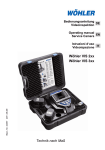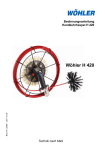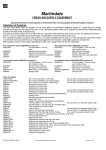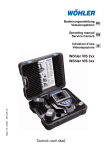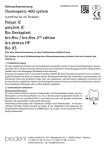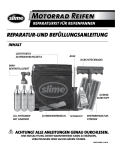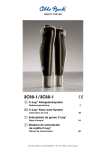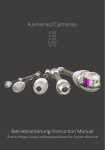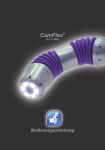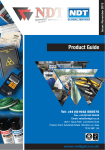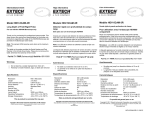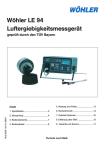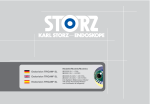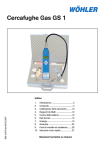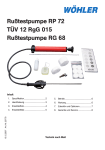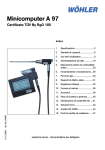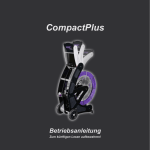Download VIS 2000 Kamerahaspel VIS 2000 Camera Viper VIS 2000 Aspo
Transcript
VIS 2000 Kamerahaspel VIS 2000 Camera Viper 31.03.2008 Art. Nr. 21645 VIS 2000 Aspo telecamera 1. Deutsch .................................................... 3 2. English.....................................................20 3. Italiano.....................................................34 Kamerahaspel VIS 2000 mit digitaler Meterzählung Inhalt 1. Spezifikation ........................................... 4 5. Hinweise zu Wartung und Pflege....... 9 2. Bedienung................................................ 5 6. Systemkomponenten..........................10 3. Stangenwechsel..................................... 7 7. Zubehör/Ersatzteile.............................15 4. Führungshilfen bei der Inspektion.... 8 8. Konformitätserklärung........................16 Technik nach Maß 1. Spezifikation Kamerahaspel VIS 2000 1. Spezifikation Das Videoinspektionssystem VIS 2000 ermöglicht die optische Kontrolle und Dokumentation in Rohren und Schächten, z.B. Abgasanlagen, Lüftungsanlagen, Abwasserrohren, etc. Das breite Spektrum der untereinander kompatiblen Systemkomponenten bietet die Auswahl einer individuellen und sehr gut auf die jeweilige Aufgabe abgestimmten Kamerazusammenstellung. Die hier beschriebene Kamerahaspel dient dem Transport und der komfortablen Handhabung der bis zu 30m langen Kamerastange während der Inspektion. Mit dem Haspelfuß, der Koppelhalterung und dem Klappgriff bietet sie 3 verschiedene Möglichkeiten der Bedienung je nach Arbeitsumgebung. So bleiben bei der Benutzung am Koppel oder mit Haspelfuß beide Hände frei für Monitor und Stangenführung. Horizontal und vertikal verlaufende Rohre können einfach und schnell, auch von wechselnden Inspektionsöffnungen aus, kontrolliert werden. Die integrierte Meterzählung mit einer hohen Auflösung von 0,05 Metern und einer Null-Taste ermöglicht eine genaue Positionsbestimmung der Schadstelle sowie Abstandsmessungen im Rohr. Technische Daten: Korb-Ø: Breite: Drehübertragung: Gewicht: Verbindungskabel: 42 cm 10 cm bis 30 m 2.000 g (ohne Stange) 2,5 m lang Integrierte Meterzählung: Funktionsprinzip: digital Auflösung: 0,05 m Messbereich: 0 - 30,00 m Bedien-Taste: Nullstellung, Parametereingabe Bereitschaftsanzeige LED 4 Hotline: 0 29 53 / 73 211 Fax: 0 29 53 / 73 250 2. Bedienung Kamerahaspel VIS 2000 2. Bedienung 2.1 Bedienelemente 3 2 9 8 1 6 5 4 7 1 Bedientaste (Nullstellung, Parametereingabe) 2 Kabelhalterung 3 Steckerschutz 4 Klappfuß 5 Klappgriff 6 Stangendurchführung 7 Koppelhalterung 8 Einstellschraube für Freilauf bremse 9 Kabelanschluss zum Monitor Abb. 2.1: Bedienelemente 2.2 Handhabung 2.2.1 Anschluss der Kameraköpfe Alle Kameraköpfe verfügen über eine 8-polige Kupplungs-Buchse, über die sie mit der Haspel verbunden werden (8-poligen Kabelstecker). Stecken Sie die Kupplungs-Buchse des Kamerakopfes auf den Stangenanschluss des Kamerakabels und drehen Sie anschließend das Gewindestück an der Haspel zum Verschließen im Uhrzeigersinn. 2.2.2 Anschluss der Monitore Verbinden Sie den Kabelanschluss der Kamerahaspel (Abb. 1, Teil 9) mit der Eingangsbuchse am Monitor. 2.2.3 Inspektion von Rohrleitungen Rohrleitungen lassen sich mit Hilfe der Kamerahaspel VIS 2000 vertikal und horizontal inspizieren. In beiden Fällen können sie auf drei unterschiedliche Arten vorgehen: 1. Wird die Haspel während der Inspektion mittels Koppelhalterung am Koppelgürtel getragen, bleiben beide Hände frei für die Bedienung des Monitors und die Führung der Stange. e-mail: [email protected] Internet: http://mgkg.woehler.de 5 2. Bedienung 2 Kamerahaspel VIS 2000 Die Haspel kann auf den Boden gestellt werden, sobald der Haspelfuß ausgeklappt ist. Stellen Sie nun einen Fuß auf den Haspelfuß, um eine gute Standfestigkeit auch während der Bedienung zu gewährleisten. 3. Die Haspel wird während der Benutzung in der Hand gehalten. Hierzu ist der Klappgriff auszuklappen. Nachdem die Inspektion beendet ist, kann der Klappgriff eingeklappt werden, damit Stange und Kamerakopf durch den Griff geschützt sind und die Haspel schmaler wird und sich somit einfacher transportieren lässt. 2.2.4 Kabelhalterung/Steckerschutz Nach der Inspektion und dem Lösen des Monitoranschlusskabels kann dieses in Schlaufen in die Kabelhalterung geklemmt werden. Zum Schutz des Steckers vor Verschmutzung oder mechanischen Schäden kan dieser ober in die Kabelhalterung gesteckt werden. Schieben Sie nun die Kabelbefestigung in die Steckeraufnahme, damit sie beim Transport geschützt bleibt. 2.2.5 Einstellen der Freilaufbremse Die Kamerahaspel ist mit einer Freilaufbremse mit folgender Funktionalität ausgestattet: Rechtslauf leicht (ohne Bremswirkung) > Stangeneinlauf Linkslauf schwer oder leicht (mit Bremswirkung je nach Einstellung) > Stangenauslauf Dadurch wird die GFK-Stange beim Auf- und Abwickeln kontrolliert und läuft nicht selbständig aus der Haspel. Wird die Einstellschraube im Uhrzeigersinn gedreht, erhöht sich die Bremswirkung. In entgegengesetzter Richtung verringert sich die Bremswirkung und die Stange lässt sich leichter aus dem Korb ziehen. 2.3 Digitale Meterzählung In der Haspel ist eine digitale Meterzählung integriert, so dass die Position der Schadstelle während der Inspektion genau bestimmt werden kann und außerdem eine genaue Abstandsmessung im Rohr möglich ist. Die Betriebsbereitschaft der Meterzählung wird durch eine grüne LED angezeigt, die aufleuchtet, sobald der Kamerakopf eingeschaltet ist. Das Ergebnis der Meterzählung wird auf dem Monitor abgelesen. Dazu ist ggf. das Bildschirmmenü des Monitors entsprechend zu konfigurieren Eine Bedientaste ermöglicht es, die Meterzählung an beliebiger Position, z.B. am Schornsteineingang, auf Null zu setzen. Der Weg des Kabels bis zum Schornsteineingang wird so nicht mitgezählt, und die genaue Position der Schadstelle im Schacht wird angegeben. Zur Abstandsmessung setzen sie die Metrierung beim Ausgangspunkt auf Null und lesen dann bequem am Endpunkt den Abstand ab. 6 Hotline: 0 29 53 / 73 211 Fax: 0 29 53 / 73 250 3. Stangenwechsel Kamerahaspel VIS 2000 3. Stangenwechsel bzw. erstmaliger Einbau Zum Austausch der GFK-Stange wird zunächst die vorhandene Stange vorsichtig bis zum Ende herausgezogen. (bei Bedarf den Korb leicht mitbewegen). Die Steckverbindung zwischen Stange und Haspel ist nun zu trennen und die Stange herauszunehmen. Drehen Sie nun die Haspel im Uhrzeigersinn knapp eine Drehung bis zum Anschlag vorsichtig zurück. Führen Sie die Kupplungsbuchse der neuen Stange durch die Öse zur Steckeraufnahme und verbinden Sie sie mit dem Stecker der Haspel. Jetzt können Sie die Stange linksherum aufwickeln. Beim Hereinschieben der Stange sollte darauf geachtet werden, dass sie sich gleichmäßig über die Breite des Haspelkorbes aufwickelt. Durch einseitiges Aufwickeln kann die GFK-Stange unter Umständen aus dem Haspelkorb springen. Stellen Sie die Freilaufbremse wie unter Punkt 2.2.5 beschrieben, ein. Sollte ein Kabel anderer Länge eingesetzt werden, ist eine Programmierung der Parameter notwendig. Während des Einschaltens des Monitors die Taste der Aufwicklung gedrückt halten und nach ca. 3 Sekunden loslassen. Die Parameter werden in der 1. Zeile angezeigt. Mit Doppelklick lässt sich der blinkende Cursor nach rechts bewegen, mit Einmalklick der Zähler verändern. Abspeichern lassen sich die Werte mit einem 3 Sekunden Dauerklick. Anschließend werden die aktuellen Parameter neu angezeigt, ebenso die Längenanzeige. Sollten Stangen oder Kabel mit anderen Längen aufgezogen werden, so sind die Parameter entsprechend dieser Tabelle zu ändern: Typ Länge Im Da Di K-Aufw. 20m 695 24 19 K-Aufw. 30m 1042 27 19 K-Haspel 42 20m 382 42 38 K-Haspel 42 30m 573 42 36 K-Haspel 36 20m 561 36 32 K-Haspel 36 30m 868 36 30 e-mail: [email protected] Internet: http://mgkg.woehler.de 7 4. Führungshilfen bei der Inspektion Kamerahaspel VIS 2000 4. Führungshilfen bei der Inspektion Im Folgenden sollen einige allgemeine Empfehlungen zum Einsatz von Führungshilfen bei der Inspektion von Rohren und Schächten gegeben werden, die wir aus unserer bisherigen Erfahrung gewonnen haben. Da jedes Rohr- und Schachtsystem individuell verschieden ist, muss natürlich in jedem Einzelfall vor Ort über die Benutzung der Hilfen entschieden werden. Bei der Auswahl der geeignetsten Führungshilfe ist zu beachten, dass diese neben einer guten Führung ein problemloses Hineinschieben wie Hinausziehen des Kamerakopfes gewährleisten muss. Die Gefahr eines möglichen Verklemmens oder Verhakens der Führungshilfe im Rohr ist zu berücksichtigen. Inspektion eines Rohres Ø 40 - 50 mm Benutzen Sie das Videoinspektionssystem immer ohne Zubehör. Inspektion eines Rohres Ø 50 -70 mm Benutzen Sie das Videoinspektonssystem immer ohne Zubehör. Verwenden Sie die Schubhüle ausschließlich im waagerechten Teil, wenn Wasser oder Schlick vorhanden ist. Inspektion eines Rohres Ø 70 - 100 mm Die Inspektion ist problemlos mit und ohne Schubhülse möglich. Für Fallrohre oder für die vertikale Inspektion ist ein Führungsgewicht zu nutzen. Inspektion eines Rohres Ø 100 - 125 mm Es können ein Zentrierstern und/oder eine Schubhüle bzw. eine Schubhülse mit Objektivschutz genutzt werden. Inspektion eines Rohres ab Ø 154 8 Hotline: 0 29 53 / 73 211 Siehe oben, allerdings ist der Kamerakopf nur wenige Meter zu schieben. Fax: 0 29 53 / 73 250 5. Hinweise zu Wartung und Pflege Kamerahaspel VIS 2000 5. Hinweise zu Wartung und Pflege Reinigen Sie die Haspel mit einem feuchten Tuch und ggf. einem milden Reinigungsmittel. Achten Sie dabei unbedingt darauf, dass kein Wasser in den Bereich der Meterzählung dringt. Achtung: Das Gerät ist vor dem Öffnen von jeglicher Spannungsquelle (Monitoreinheit etc.) zu trennen. In jedem Fall sollten Arbeiten an der Kamerahaspel nur von einem von Wöhler zugelassenen Fachbetrieb vorgenommen werden. 5. Systemkomponenten Zur Anpassung an die jeweilige Inspektionsaufgabe bietet das Videoinspektionssystem VIS 2000 eine Vielzahl verschiedener, untereinander kompatibler Bausteine im Bezug auf die Auswahl von: • Monitor- und Steuereinheit • Kamerakopf • Verbindungskabel / -stange • Zubehör Durch Kombination der Module kann für die jeweilige Aufgabe die optimale Ausstattung zusammengestellt werden. Auch spätere Ergänzungen des Systems im Hinblick auf neue Aufgaben sind jederzeit möglich. Abb. 2 zeigt die verschiedenen Komponenten im Überblick. Auf den nachfolgenden Seiten werden diese inkl. des zusätzlich erhältlichen Zubehörs kurz beschrieben. e-mail: [email protected] Internet: http://mgkg.woehler.de 9 6. Systemkomponenten Kamerahaspel VIS 2000 6. Systemkomponenten Abbildung 6.1: Systemkomponenten 10 Hotline: 0 29 53 / 73 211 Fax: 0 29 53 / 73 250 6. Systemkomponenten Kamerahaspel VIS 2000 6.1 Farbmonitor VIS 2000 (Best.-Nr. 7915 J) Der Farbmonitor VIS 2000 ist ein kompakter, leichter Monitor, der in einer Ledertasche mit Blendschutz und Tragegurt vor dem Körper getragen werden kann. Im Bildschirmmenü können Datum, Uhrzeit, ein beweglicher Cursor sowie ein Titel mit 10 Zeichen eingeblendet werden. Der Farbmonitor ist kompatibel zu allen Kameraköpfen. 6.2 Farbmonitor VIS 2000PRO (Best.-Nr. 6836 J) Mit dem Farbmonitor VIS 2000PRO ist es jetzt möglich, einzelne Bilder, wie auch Video-Sequenzen digital über den integrierten Karten Slot auf eine CF-Speicherkarte aufzunehmen. Die gespeicherten Bilder (.jpg) und Videosequenzen (.mov) können direkt vom Monitor über die CF-Speicherkarte leicht auf einen PC ausgelesen werden. Die integrierte Menüeinblendung stellt Längenanzeige, Datum und Uhrzeit als auch einen Titel am großen Farb-TFTDisplay dar. Der Farbmonitor ist kompatibel zu allen Kameraköpfen e-mail: [email protected] Internet: http://mgkg.woehler.de 11 6. Systemkomponenten Kamerahaspel VIS 2000 6.3 Miniatur Kamerakopf VIS 2000 Farbe (Best.-Nr. 7817 J) Miniatur-Kamerakopf schwarz-weiß (Best.-Nr. 7871 J) Der Miniatur Kamerakopf ist ein bis zu 3 bar wasserdichter Kamerakopf im robusten Edelstahlgehäuse, der über ein Weitwinkelobjektiv (f 2,5 mm) verfügt. Aufgrund seines kleinen Durchmessers von nur 26 mm, der kurzen Baulänge und der robusten flexiblen Stangenanbindung lässt sich der Miniatur Kamerakopf auch in engen Leitungen durch mehrere Bögen hindurch problemlos einsetzen. Anwendung: Der Miniatur-Kamerakopf ist hervorragend geeignet zur optischen Inspektion und Kontrolle von Kanälen, Rohren, Abgasleitungen, Lüftungsleitungen und Ringspalte mit Durchmessern von ca. 40 mm bis 100 mm. Speziell der Miniatur Kamerakopf s/w ist durch seine außerordentliche Lichtempfindlichkeit auch für die Kontrolle von Schornsteinen bis 20 x 20 cm und Abgasleitungen bis 30 cm Durchmesser geeignet. 6.4 Kamerakopf VIS 2000 Farbe (Best.-Nr. 7806 J) (Kamerakopf VIS 98 s/W (Best.Nr. 7801 P) Die Kameraköpfe VIS 2000 Farbe und VIS 98 s/w sind spritzwassergeschützt durch ein vollständig gekapseltes Alugehäuse. Das Objektiv ist jeweils unter der Glaskuppel um 180° schwenkbar und um 360° drehbar. Durch zuschaltbare helle Lichtkörper kann der Fernbereich ausgeleuchtet werden. Der Kamerakopf ist mit einem Weitwinkelobjektiv (f = 2,0 mm) ausgestattet. Anwendung: Die Kameraköpfe sind hervorragend geeignet zur Dokumentation von Schäden und zur Kontrolle in Abgas- und Lüftungsanlagen sowie zur vorbereitenden Inspektion bei Sanierungsarbeiten an Abgasanlagen ab einem Durchmesser von ca. 70 mm.. 12 Hotline: 0 29 53 / 73 211 Fax: 0 29 53 / 73 250 6. Systemkomponenten Kamerahaspel VIS 2000 6.5 Endoskop Kamerakopf Farbe (Best.-Nr. 8697 J) Der Endospop Kamerakopf Farbe wird vor allem zur Dokumentation endoskopischer Aufnahmen für die gutachterliche Tätigkeit eingesetzt. Außerdem ermöglicht er die Visualisierung des Endoskopbildes für mehrere Betrachter. 6.6Video Inspektionssystem-Zubehör 6.6.1 Kamerahalterung (Best.-Nr. 8680 J) Die Kamerahalterung ist mit einem Verbindungskabel und einem Gewinde M10 ausgestattet und kann so bequem auf alle GFK-Stangen montiert werden. Sie ist sowohl bei der vertikalen als auch bei der horizontalen Inspektion einsetzbar. Der Kamerakopf wird im Schutzkorb mit Blickrichtung nach unten hinten positioniert, so dass einfallendes Tageslicht bei der Inspektion von Schornsteinen nicht blendet. 6.6.2 Kamerafederführung (Best.-Nr. 8633 J) Die Kamerafederführung erleichtert die Führung des Kamerakopfes am Kabel in vertikalen Kanälen, indem sie das Verdrehen und Pendeln des Kopfes verhindert. Die Feder ist auf die jeweilige Schornsteingröße einstellbar. 6.6.3 Teleskop-Rollbock (Best.-Nr. 5706 L) Mit dem Teleskop-Rollbock lässt sich der Kamerakopf am Kabel kontrolliert herablassen. Da er aus Edelstahl hergestellt ist, ist er besonders leicht und stabil. Er ist von 22 auf 40 cm ausziehbar. e-mail: [email protected] Internet: http://mgkg.woehler.de 13 6. Systemkomponenten 6.6.4 Kamerahaspel VIS 2000 Stabilisierungshülse mit Leinsternhalter (Best.-Nr. 3590 J) Zur Stabilisierung der Kameraköpfe VIS 2000 auf den Kamerastangen beim Durchstoßen großer Leitungen; einschraubbar in den Kamerakopf, die Rollenführung oder die Kameraführung; Zur Führung beim Herabstoßen, z.B. im Schonrstein, kann ein Leinstein aufgesteckt werden (nicht im LIeferumfang enthalten) 6.6.5 LED Zusatzbeleuchtung (Best.-Nr. 9377 P und 9177 P) Die LED Zusatzbeleuchtung mit rot-gelben und mit weißen LEDs zur Arbeit mit den Kameraköpfen VIS 98 und 2000 ermöglicht die Ausleuchtung des Fernbereiches während der Inspektion. Die Zusatzbeleuchtung lässt sich einfach auf den Kamerakopf aufschieben. 6.6.6 Digitaler Bildwandler (Best.-Nr. 6233 J) Mit Hilfe des digitalen Bildwandlers können Bilder über eine USB-Schnittstelle auf ein Notebook oder einen PC gespeichert werden. 14 Hotline: 0 29 53 / 73 211 Fax: 0 29 53 / 73 250 7. Zubehör Kamerahaspel VIS 2000 6.6.7 Kabelaufwicklung VIS 2000 und SK 95 (Best.-Nr. 7816 J) Die praktische Kabelaufwicklung mit patentiertem, robusten Drehübertrager lässt sich während der Inspektion mit einem Schultergurt gut vor dem Körper tragen. Für den Transport kann sie samt Monitor zusammengeklappt werden. 7. Zubehör/Ersatzteile 7.1Transportkoffer XXL (Best.-Nr. 5824 L) mit Schultergurt. Garantiert den sicheren Transport der Kamerahaspel samt Zubehör 7.2 Kamerastangen GFK-Kamerastange schwarz, flexibel, 6 mm Ø, 5 m lang Best.-Nr. 7821 J GFK-Kamerastange schwarz, flexibel, 6 mm Ø, 20 m lang Best.-Nr. 7818 J GFK-Kamerastange schwarz, flexibel, 6 mm Ø, 30 m lang Best.-Nr. 7819 J GFK-Kamerastange rot, semiflexibel, 7 mm Ø, 5 m lang Best.-Nr. 7305 J GFK-Kamerastange rot, semiflexibel, 7 mm Ø, 20 m lang Best.-Nr. 7829 J GFK-Kamerastange rot, semiflexibel, 7 mm Ø, 30 m lang Best.-Nr. 7306 J e-mail: [email protected] Internet: http://mgkg.woehler.de 15 8. Konformitätserklärung Kamerahaspel VIS 2000 8. EG-Konformitätserklärung Für das folgend bezeichnete Produkt Videoinspektionsgerät VIS 2000 wird hiermit bestätigt, dass es den wesentlichen Schutzanforderungen entspricht, die in den Richtlinien des Rates zur Angleichung der Rechtsvorschriften der Mitgliedstaaten über die elektomagnetische Verträglichkeit (89/336/EWG und 93/97/EWG) festgelegt sind. Zur Beurteilung des Produkts hinsichtlich der elektromagnetischen Verträglichkeit wurden folgende Normen herangezogen: EN 55024 Störfestigkeit EN 55022 Störaussendung Dieser Erklärung wird verantwortlich für den Hersteller/Importeur Wöhler Messgeräte Kehrgeräte GmbH Adresse: Schützenstr. 38, D-33181 Bad Wünnenberg abgegeben durch: Dipl.-Phys. Johannes Lötfering, Geschäftsführer 16 Bad Wünnenberg, Hotline: 0 29 53 / 73 211 28.10.2004 Fax: 0 29 53 / 73 250 9. Garantie und Service Kamerahaspel VIS 2000 9. Garantie und Service 9.1 Garantie Jede Kamerahaspel VIS 2000 wird im Werk in allen Funktionen geprüft und verlässt unser Werk erst nach einer ausführlichen Qualitätskontrolle. Bei sachgemäßem Gebrauch beträgt die Garantiezeit auf den Monitor 12 Monate. Ausgenommen sind Verschleißteile und Verbrauchsmaterialien. Die Kosten für den Transport und die Verpackung des Geräts im Reparaturfall werden von dieser Garantie nicht abgedeckt. Diese Garantie erlischt, wenn Reparaturen und Abänderungen von dritter, nicht autorisierter Stelle an dem Gerät vorgenommen wurden. Der SERVICE wird bei uns sehr groß geschrieben. Deshalb sind wir auch selbstverständlich nach der Garantiezeit für Sie da. • Es erfolgt eine sofortige Reparatur, wenn Sie mit Ihrem Gerät zu uns nach Bad Wünnenberg kommen. • Sie schicken das Gerät zu uns, wir reparieren es innerhalb weniger Tage, und schicken es Ihnen mit unserem Paketdienst. • Sie erhalten gegen einen geringen Pauschalbetrag ein Leihgerät gestellt. • Sofortige Hilfe erhalten Sie durch unsere Techniker am Telefon. e-mail: [email protected] Internet: http://mgkg.woehler.de 17 9. Garantie und Service Kamerahaspel VIS 2000 9.2 Verkaufs- und Servicestellen Deutschland Wöhler Messgeräte Kehrgeräte GmbH Schützenstr. 41 33181 Bad Wünnenberg Tel.: +49 29 53 / 73 - 211 Fax: +49 29 53 / 73 - 250 e-mail: [email protected] http://mgkg.woehler.de Verkaufs- und Servicestelle Rhein/Ruhr Wöhler Messgeräte Kehrgeräte GmbH Castroper Str. 105 44791 Bochum Tel.: +49 2 34 / 51 69 93 - 0 Fax: +49 2 34 / 51 69 93 - 99 e-mail: [email protected] Niederbayern-Oberpfalz Reinhilde Ortner St.-Erasmus-Str. 5 94469 Deggendorf/Deggenau Tel.: +49 9 91 / 3 70 85 - 0 Fax: +49 9 91 / 3 70 85 - 16 Berlin Catrin Kortze Löwestr. 18 10249 Berlin Tel.: +49 30 / 42 65 102 - 720 Fax :+49 30 / 42 65 102 Verkaufs- und Servicestelle Süd Wöhler Messgeräte Kehrgeräte GmbH Gneisenaustr.12 80992 München Tel.: +49 89 / 15 89 223 - 0 Fax: +49 89 / 15 89 223 - 99 e-mail: [email protected] 18 Hotline: 0 29 53 / 73 211 Fax: 0 29 53 / 73 250 9. Garantie und Service Kamerahaspel VIS 2000 Im europäischen Ausland: Czech Republic Wöhler Bohemia s.r.o. Za Naspem 1993 393 01 Pelhrimov Tel.: +420 56 53 49 019 Fax: +420 56 53 23 078 e-mail: [email protected] Italy Wöhler Italia srl Piazza Mazzini 12 39100 Bolzano Tel.: +39 0471 40 2422 Fax: +39 0471 40 6099 e-mail: [email protected] Sweden Svenska Mätapparater F.A.B. SWEMA, 123 56 Farsta Tel.: +46 8 - 94 00 90 Fax: +46 8 - 93 44 93 Norway Varmeokonomi 3178 Vale Tel.: +47 33 06 -10 41 Fax: +47 33 06 - 01 62 Poland Jeremias Spólka z o.o., 62-200 Gniezno Tel.: +48 614 - 28 46 20 Fax: +48 614 - 24 17 10 Croatia STURM d.o.o. 51215 Kastav Tel.: +385 51 - 22 50 73 Fax: +385 51 - 22 46 31 Great Britain Wöhler UK Derbyshire DE56 HNP Tel./Fax: +44 17 73 82 11 44 OEG Nord Tel.: +33 14691152-7 Fax: +33 14691152-8 [email protected] Hungary Lipták Fivérek, 5600 Békéscsaba Tel./Fax: +36 66 441 611 Slowakia Republic Kominsystem s.r.o. 91501 Nove Mesto nad Vahom Tel./Fax: +421 32 77 16 542 Finland Avatermos OY 20700 Turku Tel.: +358 22 325 - 229 Fax: +358 22 325 - 279 Netherlands Imbema van Vugt JR. B.V. 1221 JV Hilversum Tel.: +31 35 68 - 38 444, Fax: + 31 35 68 - 53 764 Luxembourg Ramirez-Electro S.A. 4384 Ehlerange Tel.: +352 26 55 451 Fax: +352 26 55 1245 J. Feije 2071 VH Santpoort - N. Tel.: +31 23 - 53 81 803 Fax: +31 23 - 53 74 298 Turkey Bacamarket Ltd. Sti. 34425 Kozyatagi - Istanbul Tel.: +90 212 24 57 - 891 Fax: +90 212 24 57 - 894 Switzerland Bösch Spezialbürsten 9443 Widnau Tel.: +41 71 722 - 18 59 Fax: +41 71 722 -18 52 Rocco Ditaranto 8264 Eschenz Tel./Fax: +41 52 741 - 44 50 France Self - Climat 77200 Torcy Tel.: +33 1 60 - 05 18 53 Fax: +33 1 60 - 17 58 39 USA Wohler USA Inc. 20 Locust Street, Suite 205 Danvers, MA 01923 United States of America Tel.:+1 978 7 50 98 76 Fax.: +1 978 7 66 24 87 e-mail: service@wohlerusa. com Art.-Nr.: 21645 e-mail: [email protected] Internet: http://mgkg.woehler.de 19 Camera Viper VIS 2000 with metric marking Contents 1. Specification ........................................21 5. System Components...........................26 2. Operation................................................22 6. Accessories/Spare parts...................31 3. Changing the rod.................................24 7. Declaration of Conformity..................32 4. Maintenance..........................................25 8. Guaranty and Service.........................33 The Measure of Technology Camera Viper VIS 2000 1. Specifikation 1. Specification The video inspection system is ideal for the optical control and examination of horizontally and vertically running exhaust systems (modern chimneys) as well as for sewers and ventilation systems with a diameter from 40 mm Ø. The compatible system components offer various individual solutions which are perfectly convenient for the corresponding job. The camera viper described in this manual is used for the transport and the handling of camera rods up to 30 m during the inspection. Viper stand, belt attachment and retractable grip offer three diferent possibilities of handling, depending on the working conditions. If the user decides to carry the viper at the belt or to put it on its feed, his hands will be free for working with the monitor and the rod. Horizontally and vertically running exhaust systems will be controlled simply and quickly. The integrated metric marking with a high resolution of 0.05 meters and a zero-setting button enables an exact determination of the position of the defect as well as the measurement of distances in the exhaust system. Technical Data: Basket-Ø: Width : Transmittance: 42 cm 10 cm up to 30 m Weight: Connection cable: 2000 g (without rod) 2.5 m long Integrated metric marking: Functional principle: Resolution: Measuring Range: Buttons: Stand-by digital 0,05 m 0 - 30,00 m Reset, input of parameters LED e-mail: [email protected] Internet: http://mgkg.woehler.com 21 Camera Viper VIS 2000 2. Operation 2. Operation 2.1 Controls 3 2 1 Operation button (Reset to zero, input of parameters) 2 Cabel support 3 Jacket protection 4 Collapsible stand 5 foldable grip 6 Rod duct 7 Belt support 8 Adjusting screw for free-wheel bracket 9 Cable connection to the monitor 9 8 1 6 5 4 7 Figure 2.1: Controls 2.2 Operation 2.2.1 Connection of the camera heads All camera-heads are connected via a clutch socket with 8 poles to the camera viper (cable jack with 8 poles). Plug camera head and camera cable together and then turn the thread clockwise for closing the screw connection tightly. 2.2.2 Connection of the monitors Stick the cable connection (fig. 2.1, part 9) to the socket of the monitor. 2.2.3 Inspection of exhaust systems The camera viper VIS 2000 can be used for the inspection of horizontally and vertically running exhaust systems. In both cases you can work two different ways. 22 Hotline:+49 29 53 / 73 211 Fax: +49 29 53 / 73 250 Camera Viper VIS 2000 2. Operation 1. If you fix the viper to the belt during the inspection, both hands will be free for handling the monitor and the rod. 2 You can also put the viper on the floor when the stand is opened. Please put your food on the viper stand to garantize stableness during the inspection. 3. You might also simply carry the viper in your hand during the inspection. In this case you will have to open the grip. After the inspection you must close the grip, so that rod and camera head will be protected by the grip and the viper is smaller and may easily be transported. 2.2.4 Cable support / Jacket protection After the inspection and after the connector cable has been pulled off, the connector cable can be clamped into the straps of the cable support. Please put the jacket into the cable support for protecting it against dust or mecanical defects. Push the cabel connection into the protection device so that it will be protected during the transport. 2.2.5 Adapting the free wheeel bracket The camera viper has a free wheel bracket with the following functions: Easy running to the right (no retarding effort) > rod infeet Hard or easy running to the left (retarding effort depends on the adjustment) > rod escape This way, the rod is controlled during the rolling in and out and cannot run out of the viper. If you turn the adjusting screw clockwise, the retarding effort will increase. If you turn it to the other direction, the retarding effort will decrease and you can easily pull the rod out of the basket. 2.3 Digital Metric Marking The viper has a digital metric marking integrated, so that the position of the defect can be exactly determined during the inspection and a distance measurement in the tube will be possible. The green LED shows that the metric marking is ready for operation. The LED will light up as soon as the camera head is switched on. The result of the meter measurement will be shown in the monitor. If necessary, you will have to configurate the display menu correspondingly. A special button can reset the metric marking to zero in every position, for example at the chimney entry. The way of the camera until the entry of the chimney will not be included in the measurement and the exact position of the defect in the duct will be shown. For measuring the distance, reset the metric marking to zero at the initial point (by pressing theoperation button for two seconds) and then read off the distance at the end point. e-mail: [email protected] Internet: http://mgkg.woehler.com 23 Camera Viper VIS 2000 3. Changing the rod 3. Changing or installing the rod For changing the rod, you first have to pull out the rod completely. Now disconnect the connection between rod and viper and take out the rod (if necessary, move the basket slightly). Turn the viper clockwise almost one rotation back up to the stop position. Guide the jack of the new rod through the loop to the clutch socket of the viper and connect them. Now you can roll up the viper counterclockwise. While rolling up the rod, pay attention that it coils smooth around the basket. If the rod coils one-sided, it may derail out of the basket. Fix the free-wheel-bracket as described in point 2.2.5. If you insert a rod with another legth, you will also have to change the parameters. Keep the button of the winder fixed, while starting the monitor and release the button after 3 seconds. The parameters will be shown in the first line. Move the cursor to the right with a double-click and change the number with a simple click. Store the values by clicking 3 seconds without interruption. After that the new parameters and the lenght will be displayed. If you install rods or cables with other lenghts, you will have to change the parameters acording to the following table: Type lenth running meters Cable winder 20m 695 24 19 Cable winder 30m 1042 27 19 Camera viper 4220m 382 42 38 Camera viper 4230m 573 42 36 Camera viper 3620m 561 36 32 Camera viper 3630m 868 36 30 24 Hotline:+49 29 53 / 73 211 external dimension internal dim. Fax: +49 29 53 / 73 250 4. Maintenance Camera Viper VIS 2000 4. Maintenance Clean the viper with a damp cloth only, but never with water and cleaning agent. Pay attention that no water will enter the metric marking. Attention: Before opening the device disconnect it from any voltage source. Only an authorized establishment should repare the camera viper. 5. System Components The video-inspection-system VIS 2000 offers a great number of different but compatible components to adapt the device to various special tasks, that components are: · monitor and control unit · camera head · connection cable/rod · accessories This way it is possible to combine the perfect equipment for each task. You can also complete the system later on for new tasks. Figure 6.1 shows the different components. On the next pages, the components and their accessories are shortly described. e-mail: [email protected] Internet: http://mgkg.woehler.com 25 5. System Components Camera Viper VIS 2000 5. System Components Figure 6.1: System - components 26 Hotline:+49 29 53 / 73 211 Fax: +49 29 53 / 73 250 Camera Viper VIS 2000 5. System Components 5.1 Camera head VIS 2000 Colour (Order no. 7806 J ) Camera head VIS 98 b/w (Order no. 7801) The camera heads VIS 2000 colour and VIS 98 b/w are splashproof enclosed in an aluminium housing. They enable a simple and exact inspection by the 180 o tilt and 360 o pan function of the camera head. Extra LEDs for additional light make it possible to see even at far distances. The camera head comes with a wide angle objective (f=2.0 mm). Applications: Inspection and documentation of damage in ventilation and exhaust systems from aprox. 70 mm. 5.2 Miniature camera head (Order no. 7817 J) Miniature camera head b/w (Order no. 7871 J ) The mini camera head is watertight up to 3 bar and has a durable stainless steel housing with a wide angle objective (f=2.0 mm). Because of the small diameter of only 26 mm, the short length and the flexible viper it can be used in small lines and pipes with various bows without problems. Applications: Inspection and direct documentation of flue lines and ventilations as well as water pipes with a diameter from 40 mm to 100 mm. Especially the mini camera head black and white is extremely sensitive to light and therefore convenient for the control of chimneys up to 20 x 20 cm and flue lines up to 30 cm Ø. e-mail: [email protected] Internet: http://mgkg.woehler.com 27 Camera Viper VIS 2000 5. System Components 5.3Endoscope camera head colour (Order no. 8697 J ) The Endoscope Camera Head color is used especially for the documentation of endoscopic snapshots for expertises. It also makes it possible that various persons can regard the endoscopic picture on a monitor. 5.4 Assessories Video inspection 5.4.1 Camera roller guide (Order no. 7826 J) Camera roller guide for the Camera head VIS 2000 and VIS 98, for pushing the camera head in horizontally running exhaust systems and ventilation systems and chimneys. Advantages/Features: • guidance rolls • simple installation at the camera head • special steel protection, powder coated 5.4.2 Stabilization sleeve with star holder (Order no. 3590 J) For the stabilization of the camera heads VIS 2000 and VIS 98 on the camera viper when pushing through large pipes; it is simply screwed into the roller guide. When pushing downwards, for example in the chimney, a star can be plugged on for better guiding (not included in delivery). 28 Hotline:+49 29 53 / 73 211 Fax: +49 29 53 / 73 250 Camera Viper VIS 2000 5. System Components 5.4.3 Telescope Dolly (Order no. 5706 L) For letting down the camera head at the cable. Especially light and stable because of special steel. Extendable from 22 to 40 cm. 5.4.4 LED supplementary light (Order no. 9377 P und 9177 P) The LED supplementary light with red-yellow and white LEDs, for camera head VIS 2000 and VIS 98 makes it possible to iluminate the distant zone during the inspection. 5.4.5 Cable reel VIS 2000 and SK 95 (Order no. 7816 J) Cable reel VIS 2000PRO (Order no. 3816 J) The usefull cable reel with patented stable metric marking can be carried in front of the body during the measuring with a shoulder strap. For the transport the stand can be folded. 5.4.6 Camera viper (Order no. 7822 J ) The camera viper is available with a camera rod with a diameter of 6 or 7mm diameter and a length of 20.05 m. With the viper a comfortable inspection of horizontally and vertically running exhaust systems is possible. e-mail: [email protected] Internet: http://mgkg.woehler.com 29 Camera Viper VIS 2000 5. System components 5.4.7 Viper Camera Holder (Order no. 8680 J) The camera holder provides a connection cable and a M 10 thread and therefore can easily be connected to our cleaning rods. The camera is in a protective cage and faces down, so that incidental daylight does not cause problems. Attached to rods both, horizontal and vertical pipes can be examined. 5.4.8 Camera Spring Guide (Order no. 8633 J) For centering of the camera head in vertical vents. A stainless steel spring prevents a rotating and oscillating of the camera head. The spring is adjustable to the tubing size. 5.4.8 Special Cable (Order no. 9181 L) 0.8 m, for the connection of the Camera rod to the monitor. 5.4.9 Camera rod Camera rod black, flexible, 6 mm Ø, 5 m long (Order no. 7821 J) Camera rod black, flexible, 6 mm Ø, 20 m long (Order no. 7818 J) Camera rod black, flexible, 6 mm Ø, 30 m long (Order no. 7819 J) Camera rod red, stable, 7 mm Ø, 5 m long (Order no. 7305 J) Camera rod red, stable, 7 mm Ø, 20 m long (Order no. 7829 J) Camera rod red, stable, 7 mm Ø, 30 m long (Order no. 7306 J) 30 Hotline:+49 29 53 / 73 211 Fax: +49 29 53 / 73 250 Camera Viper VIS 2000 6. Accessories 6. Accessories/Spare Parts of the Colour Monitor VIS 2000 6.1 Power Supply VIS 2000PRO (Order no. 6837 J) for mains operation and charging 6.2 Leather protection bag for monitor VIS 2000PRO (Order no. 6838 J) With glare protection and shoulder-strap. For the secure transport and a comfortable position of the monitor during the inspection. 6.3 Adaptercable (Order no. 8637 O) for the 12 volt car-system 6.4 Shoulder strap (Order no. 8136 I) Makes it possible to carry the Cable reel comfortably in front of the body, so that both hands will be free for working. e-mail: [email protected] Internet: http://mgkg.woehler.com 31 Camera Viper VIS 2000 7. Declaration of conformity 7. Declaration of conformity Manufacturer: WÖHLER Messgeräte Kehrgeräte GmbH Schützenstr. 38, 33181 Bad Wünnenberg declares that the following product: Product name: Wöhler VIS 2000 Camera viper complies with key safety requirements set down in the guidelines of the Council for the Harmonisation of the Legal Requirements of the Member States in relation to electromagnetic compatibility (89/336/EWG and 93/97/EWG). The following standards are used to assess the product in terms of electromagnetic compatibility: EN 55024 Resistance to jamming EN 55022 Emitted interference This declaration is issued on behalf of the aforementioned manufacturer by: Johannes Lötfering, Managing Director Bad Wünnenberg, 32 Fax: +49 29 53 / 73 250 Hotline:+49 29 53 / 73 211 28.10.2004 8. Guarantee and Service Camera Viper VIS 2000 8. Guarantee and Service 8.1 Guarantee Every Wöhler VIS2000 Camera Viper has been subjected to a thorough functional check and only leaves our factory after detailed quality control. The final inspection is recorded in detail in a test report and is kept by us on our premises. If the device is used correctly, the guarantee period is 12 months from the date of purchase. This guarantee does not cover wear and tear parts. The guarantee does not include the costs for transport and packing material in case of repair. It will expire, if third persons, who are not authorized, repaire or change the device. We see SERVICE as a very important element in our business. That is why we are still available to you even after the guarantee period has expired. • An immediate repair will be carried out if you bring your meter to us in Bad Wünnenberg. • If you send us the meter, it will be returned to you by our delivery service after repair in just a few days. • We can lend you a device for a small standard fee. • You can obtain immediate help from our engineers by telephone. 8.2 Service For Service Sites in Europe and USA, see page 46 at the end of this manual. e-mail: [email protected] Internet: http://mgkg.woehler.com 33 Aspo telecamera VIS 2000 con contametri integrato Indice 1. Impiego ..................................................35 5. Accessori e ricambi.............................44 2. Dati tecnici..............................................35 6. Certificato de conformità....................45 3. Informazioni utili....................................37 7. Garanzia..................................................45 4. Componenti del sistema....................38 Soluzioni tecniche su misura 1. Impiego Aspo telecamera VIS 2000 1. Impiego: L’aspo per telecamera con contametri integrato viene impiegato per spingere la testata o minitestata telecamera nella canna fumaria o nel canale da ispezionare. L’aspo telecamera permette la videoispezione dall’alto, dal basso o in orizzontale. L’aspo telecamera permette di utilizzare sia le testate VIS che le minitestate a colori o in b/n. Grazie al contametri si potrà leggere direttamente sul monitor i metri di penetrazione della videoispezione. L’aspo per telecamera si usa con la testata VIS soprattutto nella videoispezione dall’alto o di canali della ventilazione, inserendo anche lo stabilizzatore con centratore cod. 3590 (opzione). Nella videoispezione dal basso e soprattutto nella videoispezione dei secondari di canne collettive ramificate ccr si usa l’aspo con minitestata telecamera in b/n. Nella videoispezione di tubi dello scarico invece si impiega maggiormente la minitestata a colori. L’aspo dispone di cavi rigidi da 6 mm o da 7 mm, nelle lunghezze da 20 o 30 m. La scelta dovrà essere fatta in modo individuale, ma generalmente i userà l’aspo da 6 mm per gli scarichi con curve strette e il cavo rigido da 7 mm soprattutto nella ventilazione e con testata VIS. Vantaggi: Aspo telecamera compatto e semplice da usare, completo di tutti gli accessori per la videoispezione, con contametri incorporato brevettato senza contatti, cavo collegamento per l’unità monitor, frizione, gancio per cintura e pide. 2. Istruzioni d’uso: 1. scegliere l’aspo telecamera con il cavo rigido adatto per robustezza, raggio di curvatura e lunghezza 2. montare la testata adatta, scegliendo tra la minitestata colori o b/n a seconda delle esigenze (b/n vede meglio nelle canne fumarie) 3. montare il distanziatore cod. 7863 o lo specchietto 90° cod. 7923 sulla microtestata 4. collegare l’unità monitor allo speciale cavo dell’aspo 5. fissare l’aspo sulla cintura o con il piede 6. come optional Wöhler offre anche il Locator, strumento dotato di emettitore e ricevitore per poter localizzare la testata in ogni momento. L’emettitore dispone di presa e spinotto e viene interposto tra testata e cavo rigido (adatto anche per testata VIS). e-mail: [email protected] Internet: http://mgkg.woehler.com 35 Aspo telecamera VIS 2000 1. Impiego 7. regolare la vite centrale della frizione per ottenere il migliore effetto di rotolamento del cavo rigido. 8. accendere l’unità monitor e riprendere una targhetta d’identificazione dell’oggetto da ispezionare 9. inserire la testata nella canna fumaria/canale da ispezionare 10. controllare l’immagine e regolare di conseguenza contrasto e luminosità 11. premere il pulsante rosso dell’azzeramento del conametri 12. spingere l’asta nella canna fumaria/canale da ispezionare registrando dapprima le foto dei particolari e poi il filmato intero. 13. controllare l’esito della videoispezione Istruzioni d’uso testata VIS: 14. scegliere l’aspo telecamera con il cavo rigido 7mm per la videoispezione in verticale e orizzontale e 6 o 7mm per la videoispezione dall’alto 15. montare la testata adatta, scegliendo tra la testata VIS 2000 colori o VIS 98 b/n a seconda delle esigenze 16. inserire una spazzola con foro 28 mm e di misure adatte sul cavo rigido 17. staccare il cestello della guida a rotelle (opzione consigliata) girando di 1/4 di giro reinserilo sul cavo rigido 18. collegare il cavo rigido sulla presa della testata VIS 19. fissare la guida a rotelle con la grande ghiera filettata posteriore 20. rimontare il cestello protettivo 21. inserire lo stabilizzatore (opzione consigliata) sul cavo rigido con il filetto rivolto verso il cestello 22. avvitare lo stabilizzatore sulla guida a rotelle 23. inserire ora la spazzola nella sede dello stabilizzatore 24. collegare l’unità monitor allo speciale cavo dell’aspo 25. fissare l’aspo sulla cintura o con il piede 26. regolare la vite centrale della frizione per ottenere il migliore effetto di rotolamento del cavo rigido. 27. accendere l’unità monitor e riprendere una targhetta d’identificazione dell’oggetto da ispezionare 28. inserire la testata nella canna fumaria/canale da ispezionare 29. controllare l’immagine e regolare di conseguenza contrasto e luminosità 30. controllare la rotazione 180 e 360° e portare la 36 Hotline: +49 29 53 / 73 211 Fax: +49 29 53 / 73 250 2. Dati tecnici Aspo telecamera VIS 2000 31. premere il pulsante rosso dell’azzeramento del conametri 32. spingere l’asta nella canna fumaria/canale da ispezionare registrando dapprima le foto dei particolari e poi il filmato intero. 33. controllare l’esito della videoispezione 34. per i canali di ventilazione Wöhler offre anche dei carrelli al posto della guida a rotelle per poter spingere la testata VIS in canali di dimensioni maggiori. Il carrello verrà spinto direttamente dal cavo rigido 2. Dati tecnici: • cestello metallico con maniglia, gancio per cintura e piede • adatto per cavo rigido 6 o 7 mm e per lunghezze fino 30 m • cavo di collegamento unità monitor • contametri brevettato senza contatti a trascinamento • pulsante rosso di azzeramento della metratura digitale • frizione brevettata per evitare lo srotolamento accidentale del cavo rigido 3. Informazioni utili La videoispezione con cavo rigido viene eseguito soprattutto quando serve spingere la testata, ma è possibile anche per la videoispezione dall’alto. Si consiglia di tenere sempre in carica le batterie della telecamera e a portata di mano sempre alcune cupole in vetro di ricambio. È possibile sostituire anche il cavo rigido con uno di lunghezza o spessore diverso. A tale scopo si deve aprire la vite della frizione, estrarre tutto il cavo rigido e staccare la presa. Per rimontare ora un altro cavo rigido si procede prima a girare il cestello in senso antiorario fino alla battuta, poi va collegata la presa sulla presa del cestello e riavvolto il cavo rigido fino alla fine. Fissare ora la vite della frizione. Per ulteriori informazioni contattare la ns. sede Wöhler Italia di Bolzano al tel. 0471 402422 oppure il ns. centro corsi Wöhler by ditta Ecopoint, via Mantova 19, 37045 Legnago-VR, tel. 0442 602097 e-mail: [email protected] Internet: http://mgkg.woehler.com 37 4. Componenti del sistema Aspo telecamera VIS 2000 4. Componenti del sistema Il sistema di videoispezione VIS 2000 dispone di una vasta gamma di accessori e componenti per adattarsi ad ogni esigenza dell’impianto. Ogni sistema di videoispezione si compone dei 4 componenti base: · unità monitor per colori e b/n · testata telecamera colori o b/n · cavo/cavoasta di collegamento · accessori 38 Hotline: +49 29 53 / 73 211 Fax: +49 29 53 / 73 250 4. Componenti del sistema Aspo telecamera VIS 2000 Fig. 4.1: Componenti e-mail: [email protected] Internet: http://mgkg.woehler.com 39 4. Componenti del sistema Aspo telecamera VIS 2000 4.1 Testata telecamera rotativa La testata telecamera rotativa permette la videoispezione a “mezzaluna”, perché girevole a 360° e ruotabile a 180°. La testata è protetta da una cupola in vetro con protezione IP 64 contro gli spruzzi d’acqua. L’obiettivo a gran d’angolo (f=2,0mm) della telecamera è protetto contro i riflessi di luce da un anello e molla a trascinamento. La testata rotativa è particolarmente adatta per la videoispezione di canne fumarie, canali di ventilazione e canali asciutti o umidi tutti i tipi a partire da un diametro minimo di 70 mm. Esistono due versioni: VIS 2000 testata a colori, mostra bene i particolari colorati cod. 7806 VIS 98 testata bianco/nero, indicata particolarmente per le canne fumarie molto scure cod. 7801. 4.2 Microtestata fissa La microtestata fissa è a tenuta d’acqua fino 3 bar, realizzata in corpo d’alluminio e dispone di un obiettivo a gran d’angolo (f=2,5mm). Grazie al diametro ridotto di soli 2,6mm, la lunghezza contenuta e al raccordo flessibile è possibile utilizzare la microtestata anche nei canali piccoli a partire da ca. 40 mm (con max. 3 curve) fino a max. 100 mm. La microtestata b/n è particolarmente luminosa e indicata per le videoispezione di canne fumarie fino le misure 200x200mm o diametro 300mm. Esistono due versioni: Microtestata colori per canali e c.f. 7817 Microtestata b/n per canne fumarie 7871 40 Hotline: +49 29 53 / 73 211 Fax: +49 29 53 / 73 250 4. Componenti del sistema Aspo telecamera VIS 2000 4.3Testata endoscopio Permette di collegare ogni endoscopio Wöhler direttamente alla VIS 2000PRO, permettendo la memorizzazione delle immagini riprese con l’endoscopio flessibile o il tecnoendoscopio rigido. Testata endoscopio cod. 8697 4.4 Accessori vari per videoispezione Guida a rotelle, protegge la testata sia per le videoispezione dall’alto con il cavo o la sondacavo, o nei canali con spinta attraverso la sondacavo. La guida a rotelle è completa di raccordo a baionetta per il fissaggio della testata, filetto per il montaggio dello stabilizzatore con centratore. Per il montaggio togliere il cestello superiore svitandolo in senso antiorario, inserire la testata fissandola con il raccordo a baionetta e rimontare il cestello. Collegare il cavo o sondacavo. Guida a rotelle cod. 7826 Stabilizzatore con centratore, con filetto per testata o guida a rotelle, con fissaggio rapido delle spazzole con foro 28 mm, rende rigido l’attacco della sondacavo alla testata o guida a rotelle, per l’inserimento nei canali, nonché protegge la cupola dai maggiori urti laterali nella videoispezione anche di canne fumarie, nonché permette di montare una spazzola centratrice. Stabilizzatore con centratore cod. 3590 Carrucola regolabile protegge il cavo metrato durante la videoispezione, perché lo tiene dis- e-mail: [email protected] Internet: http://mgkg.woehler.com 41 Aspo telecamera VIS 2000 4. Componenti del sistema taccato dal bordo del comignolo o della portina d’ispezione del sottotetto. Inserire la carrucola con il doppio ferretto a V rivolto verso l’operatore e la doppia asta regolabile va appoggiata sulla parete opposta. Regolare la lunghezza, inserire la testata e far scorrere il cavo sulla rotella. Carrucola regolabile cod. 5706 Avvolgicavo elettronico con contametri digitale e vite di fissaggio per VIS 2000PRO, completo di piedini, freno e cavo collegamento unità monitor. Il cavo metrato invece non viene fornito, perché compreso nella telecamera. L’avvolgicavo è adatto per ricevere fino a 30 m di cavo. L’avvolgicavo elettronico trasmette i metri sullo schermo della telecamera e disopone dell’interruttore d’azzeramento. Avvolgicavo elettronico cod. 3816 Aspo elettronico con contametri digitale, piede incorporato, gancio per cintura, cavo di collegamento all’unità monitor, adatto per testata ruotabile e microtestata. L’aspo è fornito con sondacavo da 6 o 7mm e permette di spingere le diverse testate sia dal basso verso l’alto (videoispezione di secondari di ccr), che dall’alto verso il basso (canne fumarie), nonché in orizzontale (canali e tubazioni). 42 Hotline: +49 29 53 / 73 211 • aspo nero 6mm x 5m 7821 • aspo nero 6mm x 20m 7818 • aspo nero 6mm x 30m 7819 • aspo rosso 7mm x 5m 7305 • aspo rosso 7mm x 20m 7829 • aspo rosso 7mm x 30m 7306 Fax: +49 29 53 / 73 250 4. Componenti del sistema Aspo telecamera VIS 2000 Luci supplementari con led bianchi o giallo-rossi, da applicare direttamente sulla testata telecamera e con pacco 4 pile mignon in custodia da fissare sul cavo. Le luci supplementari aumentano la luce nelle canne fumarie particolarmente grandi (oltre 20 mm)oppure con le pareti completamente nere dalla fuliggine o dal catrame. Luci bianche per testata colori e b/n 9377 Luci colorate per testata b/n 9177 Guida 180°, protegge la testata ruotabile e permette la spinta mediante miniaspo 42, aspo e maxiaspo. Permette la videoispezione dal basso o di canali con vista verso l’operatore in modo da non sporcare o rompere la testata telecamera. Completo di cavo collegamento al cavo metrato e filetto M10 per la sonda dell’aspo. In testa è dotata di filetto M10 femmina per applicare una spazzola terminale come centratore. Guida 180° cod. 8680 Guida a molla per inserire la testata ruotabile al centro della canna fumaria, composto dall’anello di fissaggio e una molla con vite di fissaggio. Inserire l’anello nel filetto testata o della guida a rotelle e fissare la molla a dovuta distanza direttamente sul cavo metrato. Guida a molla cod. 8633 Custodia in similpelle per l’unità monitor (compresa nella fornitura dell’unità monitor) adatta per il montaggio delle custodie delle testate, come riportato nella foto accanto Custodia in similpelle 6838 e-mail: [email protected] Internet: http://mgkg.woehler.com 43 Aspo telecamera VIS 2000 5. Accessori e ricambi 5. Accessori e ricambi: • cavo speciale 0,8m con presa e spinotto, cod. 9181 • cavo metrato 20 m con due spinotti, cod. 9172 • cavo metrato 30 m con due spinotti, cod. 7812 • cavo prolunga 10m, metrato e con presa e spinotto, cod. 8636 • visiera aggiuntiva VIS 2000PRO cod. 6839 • distanziatore per microtestata, permette di tenere a distanza di alcuni millimetri dalla parete del canale, cod. 7863 • specchietto per microtestata, permette di vedere i particolari sia in profondità, ma anche laterali a 90°, cod. 7923 • spazzola centraggio per microtestata, diam. 150mm, cod. 8771 • spazzola centraggio per microtestata, diam. 200mm, cod. 9771 • spazzola centraggio per microtestata, diam. 250mm, cod. 8772 • carrello per la videoispezione di canali con la testata ruotabile, completo di filetto M10 e M5 per collegamento del miniaspo 42 o dell’aspo, oppure da spingere con il sondacavo dell’aspo elettronico, cod. 9548 • maxi-carrello per montare il carrello per la videoispezione ed eseguire le videoispezione nei canali con dimensioni maggiori di 300 mm, cod. 9549 • Locatore, completo di emettitore e ricevitore, permette di localizzare la posizione delle testate ruotabili o microtestate sia dietro i muri che nel suolo, cod. 3820 • valigia trasporto XXL per VIS 2000PRO, mis. 445x460x245 cod.5824 • endoscopio flessibile Ø10mm x 1.250 mm, cod. 4537 • endoscopio flessibile Ø10mm x 900 mm, cod. 4507 • endoscopio flessibile Ø10mm x 1.900 mm, cod. 4517 • tecnoendoscopio rigido, lunghezza 420mm, cod. 8655 • alimentatore per unità monitor, cod. 6837 • cinghia trasporto e lavoro per unità monitor, cod. 8136 • cupola ricambio cod. 9499 • molla per anello trascinamento obiettivo cod. 51084 • anello trascinamento per obiettivo cod. 21041 44 Hotline: +49 29 53 / 73 211 Fax: +49 29 53 / 73 250 6. Certificato di conformità Aspo telecamera VIS 2000 6. Certificato di conformità El aspo telecamera VIS 2000 è conforme le disposizioni legislative italiane ed in particolare è impiegabile per le videoispezione di canne fumarie come richiesto dalle norme UNI 10845 e UNI 1443. El telecamera VIS 2000 è inoltre adatta per la videoispezione nei canali di ventilazione e con le microtestate anche per la videoispezione delle tubazioni dell’acqua, dello scarico ecc. Il certificato conformità decade immediatamente se lo strumento viene aperto da persone o ditte non espressamente autorizzate dalla ditta Wöhler. Dichiarazione conformità CE: Il prodotto denominato VIS2000 è conforme alle norme europee per la compatibilità elettromagnetica (89/336/EWG e 93/97/EWG). Per la verifica sono state utilizzate le seguenti norme: • EN 55024 • EN 55022 Sul prodotto viene riportato il marchio CE e la seguente dichiarazione di conformità è firmata dall’amministratore delegato sig. Lötfering Johannes del produttore Wöhler MGKG GmbH – Germania – Bad Wünnenberg. La dichiarazione conformità CE decade immediatamente se lo strumento viene aperto da persone o ditte non espressamente autorizzate dalla ditta Wöhler. 7. Garanzia: Ogni aspo telecamera VIS 2000 viene controllata in tutte le sue funzioni e lascia la fabbrica solo dopo accurato controllo qualità. El aspo telecamera è coperta da garanzia 12 mesi sui difetti di fabbricazione, salvo manomissioni da parte di persone non autorizzate o di rotture dovute all’errato uso, difforme dalle istruzioni. Sono esclusi dalla garanzia i pezzi d’usura come le batterie, le cupole ecc.. I costi per il trasporto e l’imballo dello strumento in caso di necessità d’intervento è a carico del cliente. La garanzia decade immediatamente se lo strumento viene aperto da persone o ditte non espressamente autorizzate dalla ditta Wöhler. Per assicurare lunga vita al suo prodotto consigliamo una verifica periodica con pulizia e taratura dello strumento. Consigliamo concordare un appuntamento ogni 12-24 mesi e-mail: [email protected] Internet: http://mgkg.woehler.com 45 Aspo telecamera VIS 2000 7. Garanzia Servizio di assistenza programmata Per assicurare lunga vita al suo prodotto consigliamo una verifica periodica con pulizia e taratura dello strumento. Consigliamo concordare un appuntamento ogni 12-24 mesi direttamente con il SAT, il quale offre il servizio di ritiro a domicilio. Servizio Assistenza Tecnico autorizzato: ditta Ecopoint s.a.s. Ditta Wöhler MGKG GmbH Via Mantova 19 Schützenstraße 38 37045 Legnago VR D-33181 Bad Wünnenberg Tel.: 0442 602097 Tel.: 0049 2953 73211 Fax: 0442 627460 46 Hotline: +49 29 53 / 73 211 Fax: +49 29 53 / 73 250 Sales and service sites Camera Viper VIS 2000 Sales and service sites Germany: Wöhler Messgeräte Kehrgeräte GmbH Schützenstr. 41 33181 Bad Wünnenberg Tel.: +49 29 53 / 73 - 211 Fax: +49 29 53 / 73 - 250 e-mail: [email protected] http://mgkg.woehler.de Rhein/Ruhr sales and service site Wöhler Messgeräte Kehrgeräte GmbH Castroper Str. 105 44791 Bochum Tel.: +49 2 34 / 51 69 93 - 0 Fax: +49 2 34 / 51 69 93 - 99 e-mail: [email protected] Lower Bavaria and Upper Palatinate Reinhilde Ortner St.-Erasmus-Str. 5 94469 Deggendorf/Deggenau Tel.: +49 9 91 / 3 70 85 - 0 Fax: +49 9 91 / 3 70 85 - 16 Berlin Catrin Kortze Löwestr. 18 10249 Berlin Tel.: +49 30 / 42 65 102 - 720 Fax :+49 30 / 42 65 102 South sales and service site Wöhler Messgeräte Kehrgeräte GmbH Gneisenaustr.12 80992 München Tel.: +49 89 / 15 89 223 - 0 Fax: +49 89 / 15 89 223 - 99 e-mail: [email protected] e-mail: [email protected] Internet: http://mgkg.woehler.com 47 Camera Viper VIS 2000 Sales and service sites In Europe: Italy Wöhler Italia srl Piazza Mazzini 12 39100 Bolzano Tel.: +39 0471 40 2422 Fax: +39 0471 40 6099 e-mail: [email protected] Czech Republic Bohemia s.r.o. Za Naspem 1993 393 01 Pelhrimov Tel.: +420 56 53 49 019 Fax: +420 56 53 23 078 e-mail: [email protected] Sweden Svenska Mätapparater F.A.B. SWEMA, 123 56 Farsta Tel.: +46 8 - 94 00 90 Fax: +46 8 - 93 44 93 Norway Varmeokonomi 3178 Vale Tel.: +47 33 06 -10 41 Fax: +47 33 06 - 01 62 Poland Jeremias Spólka z o.o., 62-200 Gniezno Tel.: +48 614 - 28 46 20 Fax: +48 614 - 24 17 10 Croatia STURM d.o.o. 51215 Kastav Tel.: +385 51 - 22 50 73 Fax: +385 51 - 22 46 31 Great Britain Wöhler UK Derbyshire DE56 HNP Tel./Fax: +44 17 73 82 11 44 48 Hungary Lipták Fivérek, 5600 Békéscsaba Tel./Fax: +36 66 441 611 Slowakia Republic Finland Avatermos OY 20700 Turku Tel.: +358 22 325 - 229 Fax: +358 22 325 - 279 Netherlands Imbema van Vugt JR. B.V. 1221 JV Hilversum Tel.: +31 35 68 - 38 444, Fax: + 31 35 68 - 53 764 Luxembourg Ramirez-Electro S.A. 4384 Ehlerange Tel.: +352 26 55 451 Fax: +352 26 55 1245 J. Feije 2071 VH Santpoort - N. Tel.: +31 23 - 53 81 803 Kominsystem s.r.o. 91501 Nove Mesto nad Vahom Tel./Fax: +421 32 77 16 542 Turkey Bacamarket Ltd. Sti. 34425 Kozyatagi - Istanbul Tel.: +90 212 24 57 - 891 Fax: +90 212 24 57 - 894 Switzerland Bösch Spezialbürsten 9443 Widnau Tel.: +41 71 722 - 18 59 Fax: +41 71 722 -18 52 Rocco Ditaranto 8264 Eschenz Tel./Fax: +41 52 741 - 44 50 France Self - Climat 77200 Torcy Tel.: +33 1 60 - 05 18 53 Fax: +33 1 60 - 17 58 39 OEG Nord Tel.: +33 1469 1152-7 Fax: +33 1469 1152-8 [email protected] Hotline:+49 29 53 / 73 211 USA Wohler USA Inc. 20 Locust Street, Suite 205 Danvers, MA 01923 United States of America Tel.: +1 978/ 7 50 98 76 Fax.: +1 978 / 7 66 24 87 e-mail: service@wohlerusa. com Fax: +49 29 53 / 73 250
















































